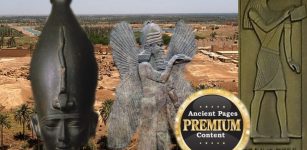Why The Aztecs Called Themselves ‘Mexica’
Conny Waters - AncientPages.com - Originally, the tribe we all know today as Aztecs, was once known as the Mexica, from which the modern name of the country of Mexico is derived.
When Aztecs found their new homeland, they changed their name to Mexica, ‘people from Mexico’.
The legend says the Aztecs came from Aztlan, which is the place of their origin, but this legendary homeland still remains unidentified. In Nahuatl language, the Aztecs -means the people who came from Aztlan and they really believed they once resided in this mythological or semi-mythological place.
The term Azteca ('Aztecah') originally meant "people of the Aztlan" and referred only to a small tribe that – after long wandering (as the last of all peoples in Central America) finally settled at Coatepec (in Nahuatl: ‘The Hill where the Snakes are‘) on the Mexican Plateau near Tula.
The starting point of the Aztec origin myth is a place known to the Mexica as Chicomoztoc, a place from which they emerged from one of seven caves. Chicomoztoc, however, was only the first stage of the supposed history of the Mexica before they finally found themselves in their historically known territory and established a regional power.
The Mexica are the source from which most of the accounts of the Aztec origin myth were recorded.

It was Alexander von Humboldt, a Prussian geographer, naturalist, explorer, who named the Mexica - the Aztecs. He put together the name “Aztlan” and “tec(atl)” where Aztlan “('Place of the Herons') was the mythical homeland of the Mexica, and -teca(h) literally means ‘people of’. Today the name 'Aztec' refers to not only the Mexica but also to the Nahuatl-speaking peoples of the Valley of Mexico and its surroundings.
Experts on Mexican history including Dr. Alejandro Villalobos, the people we call today Aztecs, became the Mexica when their god Huitzilopochtli appeared in a dream to four priests (Teomama). According to a legend, they took this name because Huitzilopochtli was also – Mexi. So, Mexica also means ‘sons of Mexi or ‘sons of Huitzilopochtli’.
In the Aztec religion, Huitzilopochtli was the national god of the Mexicas of Tenochtitlan. He was the god of war, sun, and human sacrifice and the patron of Tenochtitlan. The Mexicas founded the city of Tenochtitlan, which would eventually become the capital of the Aztec Empire.
The Aztecs/Mexica are indeed mysterious people, especially regarding their origin. There are countless theories trying to explain, who they really were.
See also:
Aztecs: Facts And History About The Ancient And Powerful Mesoamerican Civilization From Aztlán
Aztec Empire: ‘Tlatoani’ – The Ruler With The Ultimate Power In The Land
Fearsome Aztec Eagle Warriors And Jaguar Warriors Of Mesoamerica
The Toltec theory of the first wave of Mexica is that they arrived in central Mexico states around 540 BC from what is now the Southwestern US. "The Aztec Calendar Handbook," says that the so-called Aztlan and the legendary seven caves often mentioned in legends of these people was a site known today - Kanab, Utah.
Others believe the group originated in the old Tule lakes in northeastern Siskiyou County and northwestern Modoc County in California, along the border with Oregon. Still, some others propose the mythical Aztlan might be eastern Oakland.
Perhaps we’ll never know where the Mexica’s Aztlan was located but they confirmed their existence historically. Their powerful empire was founded in Tenochtitlan on an island in Lake Texcoco in the Valley of Mexico, on June 20, 1325.
Tenochtitlan was not created accidentally. According to legend, the wandering Mexica observed an eagle devouring a snake while sitting on a cactus, a sign they had supposedly been informed they would see by their patron god Huitzilopochtli upon leaving Atzlan.
Written by Conny Waters – AncientPages.com Staff Writer
Copyright © AncientPages.com All rights reserved. This material may not be published, broadcast, rewritten or redistributed in whole or part without the express written permission of AncientPages.com
More From Ancient Pages
-
 Mysterious Death Of Cambyses II – Natural, Suicide Or Assassination By Darius I The Great?
Featured Stories | Apr 21, 2021
Mysterious Death Of Cambyses II – Natural, Suicide Or Assassination By Darius I The Great?
Featured Stories | Apr 21, 2021 -
 Native Americans And European Legends Tell Peculiar Beings From The Sky Still Live On The Earth
Featured Stories | May 16, 2018
Native Americans And European Legends Tell Peculiar Beings From The Sky Still Live On The Earth
Featured Stories | May 16, 2018 -
 World Map Of Neanderthal And Denisovan DNA In Modern Humans
DNA | Apr 13, 2023
World Map Of Neanderthal And Denisovan DNA In Modern Humans
DNA | Apr 13, 2023 -
 Rio Tinto Bosses Quit Over Destruction Of One Of The Earliest Aboriginal Sites
News | Sep 12, 2020
Rio Tinto Bosses Quit Over Destruction Of One Of The Earliest Aboriginal Sites
News | Sep 12, 2020 -
 Surprising Ancient Secrets Of The ‘Second Thoth’ And God Osiris
Egyptian Mythology | Sep 27, 2018
Surprising Ancient Secrets Of The ‘Second Thoth’ And God Osiris
Egyptian Mythology | Sep 27, 2018 -
 People With Blue Eyes Have One Common Ancestor Who Appeared 10,000 Years Ago
Civilizations | Feb 24, 2017
People With Blue Eyes Have One Common Ancestor Who Appeared 10,000 Years Ago
Civilizations | Feb 24, 2017 -
 What Does The Mexican Codex Map Represent?
Ancient History Facts | May 21, 2018
What Does The Mexican Codex Map Represent?
Ancient History Facts | May 21, 2018 -
 Bulla Felix: Legendary Italian Leader Of Outlaws Who Robbed The Rich And Gave To The Poor
Featured Stories | Mar 23, 2023
Bulla Felix: Legendary Italian Leader Of Outlaws Who Robbed The Rich And Gave To The Poor
Featured Stories | Mar 23, 2023 -
 Book Of Deer And The Lost Scottish Monastery – Archaeologists Report New Finds
Archaeology | Jan 10, 2018
Book Of Deer And The Lost Scottish Monastery – Archaeologists Report New Finds
Archaeology | Jan 10, 2018 -
 Vikramashila: India’s Main Intellectual And Learning Center Of Tantric Buddhism
News | Sep 19, 2015
Vikramashila: India’s Main Intellectual And Learning Center Of Tantric Buddhism
News | Sep 19, 2015 -
 Lavish Home And Exotic Garden Of Emperor Caligula Discovered In Rome
Archaeology | Nov 19, 2020
Lavish Home And Exotic Garden Of Emperor Caligula Discovered In Rome
Archaeology | Nov 19, 2020 -
 Acta Diurna: World’s First Newspaper Appeared In 131 B.C
Ancient History Facts | Jun 10, 2019
Acta Diurna: World’s First Newspaper Appeared In 131 B.C
Ancient History Facts | Jun 10, 2019 -
 A 2,000-Year-Old Tomb Of A Roman Physician And His Medical Instruments Found In Hungary
Archaeology | May 2, 2023
A 2,000-Year-Old Tomb Of A Roman Physician And His Medical Instruments Found In Hungary
Archaeology | May 2, 2023 -
 Mysterious Headless Skeleton May Be Sir George Yeardley – The Man Who Shaped Early America
Archaeology | Aug 11, 2018
Mysterious Headless Skeleton May Be Sir George Yeardley – The Man Who Shaped Early America
Archaeology | Aug 11, 2018 -
 Wonderful Long-Lived Nymphs In Greek And Roman Mythologies
Featured Stories | Mar 29, 2024
Wonderful Long-Lived Nymphs In Greek And Roman Mythologies
Featured Stories | Mar 29, 2024 -
 Rare 13,000-Year-Old Artifacts And Paleoindian Camp Uncovered in Connecticut Shed New Light On The First Ancient People In America
Archaeology | Mar 18, 2022
Rare 13,000-Year-Old Artifacts And Paleoindian Camp Uncovered in Connecticut Shed New Light On The First Ancient People In America
Archaeology | Mar 18, 2022 -
 On This Day In History: Vlad III Dracula Regained Throne Of Wallachia For The Third Time – On Nov 26, 1476
News | Nov 26, 2016
On This Day In History: Vlad III Dracula Regained Throne Of Wallachia For The Third Time – On Nov 26, 1476
News | Nov 26, 2016 -
 3,300-Year-Old Mycenaean-Like Seal And Dagger Discovered In Turkey
Archaeology | Jul 22, 2022
3,300-Year-Old Mycenaean-Like Seal And Dagger Discovered In Turkey
Archaeology | Jul 22, 2022 -
 3D Scans Reveal Secrets Of Rare Ancient Canoe From Lake Mendota In Wisconsin
Archaeology | Jun 3, 2022
3D Scans Reveal Secrets Of Rare Ancient Canoe From Lake Mendota In Wisconsin
Archaeology | Jun 3, 2022 -
 Did The Unique Gjermundbu Viking Helmet Belong To A Warrior Who Served Rulers In The East?
Archaeology | Feb 8, 2022
Did The Unique Gjermundbu Viking Helmet Belong To A Warrior Who Served Rulers In The East?
Archaeology | Feb 8, 2022


